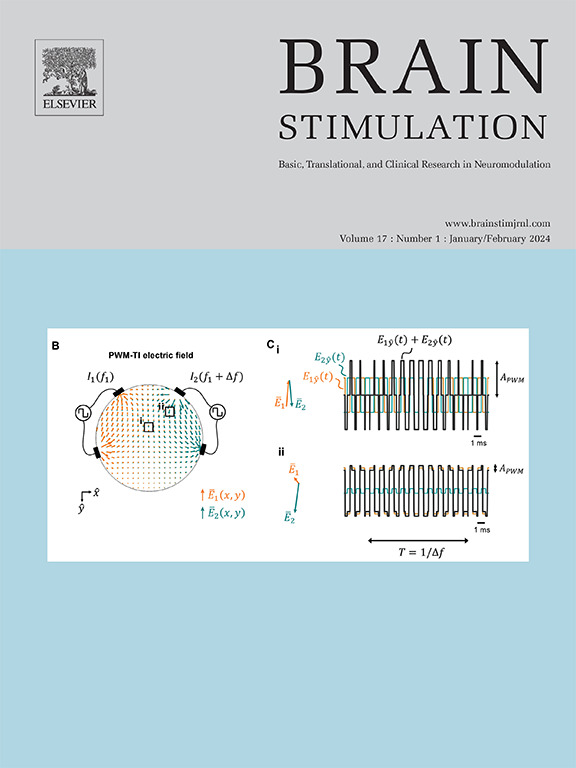Turning up the current – optimizing stimulation parameters with vagus nerve stimulation in a nationwide Norwegian cohort (The NOR-current study)
IF 7.6
1区 医学
Q1 CLINICAL NEUROLOGY
引用次数: 0
Abstract
Background
Despite widespread use of vagus nerve stimulation (VNS), evidence regarding optimal stimulation titration and dosing remains limited. Significant inter-practice variability and deviation from guidelines, results in sub-optimal dosing.
Objective
Identify optimal stimulation parameters and establish target dosing for VNS therapy in epilepsy.
Methods
We linked long-term outcomes with dosing parameters in 415 patients from a VNS registry (median follow-up = 79.0 months). A generalized linear mixed model (GLMM) assessed relationships between stimulation parameters (Output Current (OC), Frequency, Pulse Width (PW), Duty cycle [DC]) and very good clinical response (≥75 % seizure frequency reduction from baseline).
Results
Output current was the strongest predictor of seizure reduction (p = 0.001). Increasing OC by 1 mA more than doubled the probability of ≥75 % seizure reduction, peaking at 2.70 mA. Greatest likelihood of ≥50 % seizure reduction was at 2.1 mA. Post-hoc analysis supported GLMM findings, showing significantly more patients (46.3 %) receiving >2.0 mA OC achieved ≥75 % seizure reduction compared with 30.7 % (p = 0.01) among patients using lower OC. Although changes in DC were not significantly associated with seizure reduction, post-hoc analysis suggested benefits from other duty cycles. Standard 250 μs PW and 20 Hz frequency were associated with best effect. Longer follow-up improved seizure control (p < 0.001); intellectual disability negatively impacted response (p = 0.005). Seizure-free patients had significantly lower total charge (122.4 vs. 250.1 mC, p = 0.014) than patients with persistent seizures.
Conclusion
Output current should be the primary focus when titrating VNS patients to optimal dose. We suggest a target range of 1.5–2.25 mA with 250 μs PW and 20 Hz frequency. Higher OC should be attempted if tolerated.
在挪威全国队列中提高电流-优化迷走神经刺激的刺激参数(NOR-CURRENT研究)。
背景:尽管迷走神经刺激(VNS)广泛使用,但关于最佳刺激滴定和剂量的证据仍然有限。显著的实践间差异和偏离指南,导致次优剂量。目的:确定VNS治疗癫痫的最佳刺激参数和目标剂量。方法:我们将来自VNS登记处的415例患者的长期结局与剂量参数联系起来(中位随访=79.0个月)。广义线性混合模型(GLMM)评估刺激参数(输出电流(OC)、频率、脉宽(PW)、占空比(DC))与非常好的临床反应(癫痫发作频率较基线降低≥75%)之间的关系。结果:输出电流是癫痫发作减少的最强预测因子(p=0.001)。OC升高1mA,癫痫发作减少≥75%的概率增加一倍以上,在2.70mA时达到峰值。2.1mA时癫痫发作减少≥50%的可能性最大。事后分析支持GLMM的发现,显示接受bbb2.0 ma OC治疗的患者(46.3%)癫痫发作减少≥75%,而接受低OC治疗的患者为30.7% (p=0.01)。虽然DC的变化与癫痫发作的减少没有显著的联系,但事后分析表明其他工作循环也有好处。标准PW为250μs,频率为20Hz,效果最佳。结论:为VNS患者滴定最佳剂量时,输出电流应是主要关注的焦点。我们建议的目标范围为1.5 - 2.25mA,功率为250μs,频率为20Hz。如果可以容忍,应该尝试更高的OC。
本文章由计算机程序翻译,如有差异,请以英文原文为准。
求助全文
约1分钟内获得全文
求助全文
来源期刊

Brain Stimulation
医学-临床神经学
CiteScore
13.10
自引率
9.10%
发文量
256
审稿时长
72 days
期刊介绍:
Brain Stimulation publishes on the entire field of brain stimulation, including noninvasive and invasive techniques and technologies that alter brain function through the use of electrical, magnetic, radiowave, or focally targeted pharmacologic stimulation.
Brain Stimulation aims to be the premier journal for publication of original research in the field of neuromodulation. The journal includes: a) Original articles; b) Short Communications; c) Invited and original reviews; d) Technology and methodological perspectives (reviews of new devices, description of new methods, etc.); and e) Letters to the Editor. Special issues of the journal will be considered based on scientific merit.
 求助内容:
求助内容: 应助结果提醒方式:
应助结果提醒方式:


